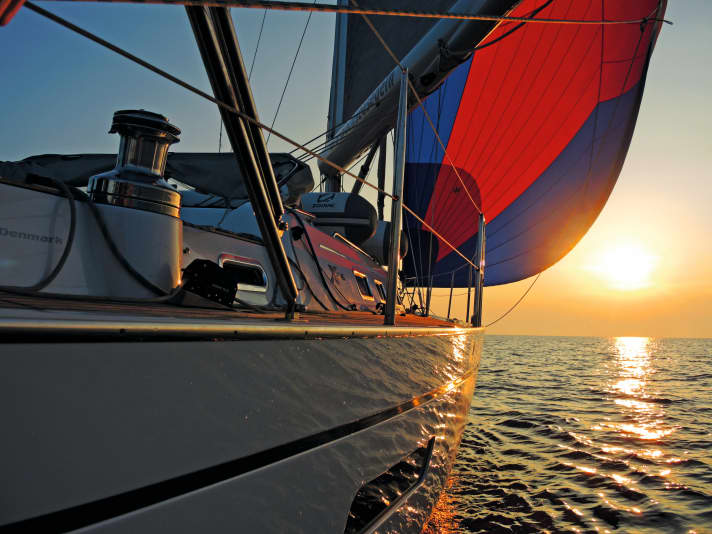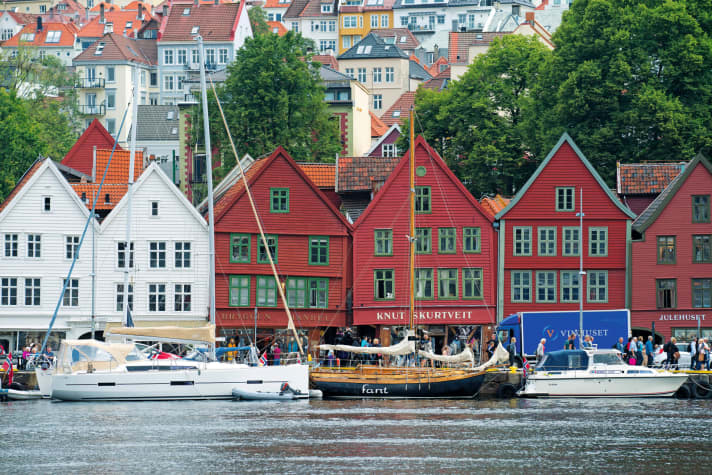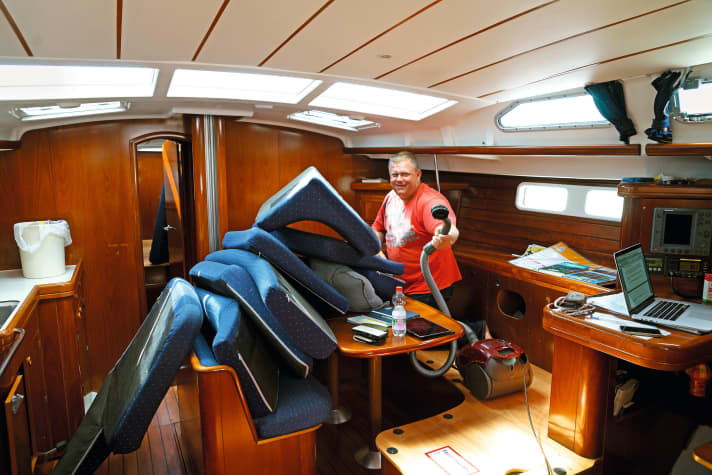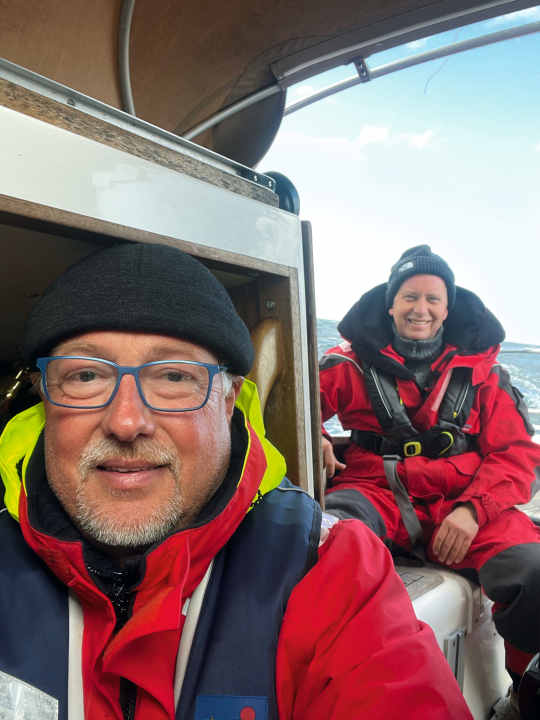Voyage: Exploring remote areas with chain cruises: This is how it can work

Spending the summer in the Danish South Seas for the seventh time? Or travelling along the German Baltic coast again? Both are undoubtedly great destinations, but the anticipation of the coming season is often accompanied by a desire for something new. This is when the classic holiday destinations pop into the minds of many northern German sailors: Swedish archipelago, Norwegian coast, Baltic states. If only there were more holiday days available.
If you don't want to wait until you retire to reach new, more distant destinations on your own keel, you should consider a chain cruise. In other words, a longer voyage that is divided into individual stages and between which the yacht may stay in a foreign harbour for a while or even spend the winter in distant shores. Individual sections can also be sailed by different crews. With a little organisational talent, the cruising radius can be extended considerably.
Good ideas are often born over a beer in the cockpit or over mulled wine on long winter evenings. This was also the case at the traditional Advent drink in the garden of Frank Müller from Bremen. The owner of the Westerly Berwick "Twee Been" would like to sail to Gothenburg in the summer, he says there - and spontaneously inspires two friends present to sail with him. Another friend continues the story: "From there, Oslo is almost round the corner ..."

In 2017 and 2020, 57-year-old Müller increased the scope of the summer cruise by loaning his yacht to sailing friends. This enabled him and his wife Ute to sail as far as the West Frisian Islands and the IJsselmeer during their holiday weeks. The route along the East Frisian Islands back to the home harbour on the Weser, which the couple already knew well, was at least partly completed by a family friend.
Now that the concept has proved its worth, it is being expanded in the current season: From the Weser, there will be two legs to Oslo. Before the journey begins in May, the batteries on board as well as the sailing wardrobe of "Twee Been" will be renewed. "A new main and a new genoa were due," says Müller. "With a view to the longer trip, I deliberately ordered these now and also treated myself to a gennaker. And thanks to the new sails, we actually used the engine even less than usual during the first leg."
Before the start, "Twee Been" was sailed to Cuxhaven. "That was a safety buffer. If we don't get out of the Weser and into the Elbe straight away because of too much wind, the trip to Gothenburg will be stressful in no time." This caution proves to be absolutely right, as the wind is really strong around Ascension Day. However, Frank Müller and his friends André Hilbers and Hardy Schilling make it from Cuxhaven to Brunsbüttel on Wednesday evening without any problems. From there, they continue through the Kiel Canal on the public holiday, travelling at up to 7.5 knots to Maasholm. The lines are tied up in the harbour on the Schlei at around 9 pm.

A great start to the early summer trip, which takes us to the Swedish coast via Dyvig and the islands of Samsø and Anholt. "Twee Been" will stay in Gothenburg for a fortnight. "I didn't organise a berth in advance," Müller reveals. "I was sure that I would find somewhere to stay with my relatively small yacht." And the Gästhamn Långedrag of Gothenburg's Kungliga Segel Sällskap did just that: "After the phone call the day before, there was a sign with my name on the free box, the harbour master can also be contacted while I'm away, there's a washing machine; it's really perfect."
The 14-day mooring costs a good 300 euros for the nine-metre yacht. On 6 June, the crew of three will take the ferry back to Kiel and from there home. "I booked the ferry trips for the entire chain cruise back in January. Of course, with the option of being able to cancel flexibly if the coronavirus does throw a spanner in the works," reports Müller.
"From Spitsbergen to Rio de Janeiro, from the Mediterranean to the Caribbean - our club yachts sail far and wide" GfS President Hans-Martin Hell
Without far-reaching pandemic-related restrictions, various club yachts will once again be able to sail their classic chain cruises throughout the season this summer. One of the true chain sailing professionals is the "Gemeinschaft für Seefahrt" (GfS) association, founded in 1970 and based in Lindau on Lake Constance. Its more than 600 members are united by their enjoyment of blue water sailing and unusual sailing areas. "Most of our trips between Spitsbergen as our northernmost destination and the dream bays of Rio de Janeiro, the Mediterranean or the Caribbean are one-way trips. That's what makes our voyages so varied," says GfS President Hans-Martin Hell, describing the recipe for success. GfS yachts have crossed the Atlantic almost 70 times.
The specialist department for offshore sailing in the Lake Constance Sailing Association operates the two club yachts "Bodan V", an XC-45, and "Brigantia", a Hallberg-Rassy 48. Due to the strong demand, a Garcia 45 was also chartered for September in order to be able to offer four one-week trips in Brittany. With "Bodan V", two-week trips will be sailed in the eastern Mediterranean this year, all one-way with a few exceptions. In addition to the two-week trips, three- and four-week trips will also be offered with "Brigantia".

The 15-metre yacht sailed from Stavanger in Norway to Inverness in Scotland at the end of May. Scotland, Northern Ireland, Ireland, the Azores, Madeira and the Canary Islands will follow before the Atlantic crossing from the Cape Verde Islands to Guadeloupe in mid-November. The "Brigantia" will not moor in a German port again until mid-October 2023. The last leg in the current cruise schedule is from Amsterdam to Cuxhaven.
Around 50 volunteer skippers, including three women, run the GfS yachts. The trips vary greatly in character. "Some crews definitely want to sail at least one night, while others focus more on spending two or three days in a particularly beautiful harbour and taking their time to look around," explains Harald Weyerich. He is responsible for public relations at the GfS.
It is important that all fellow sailors agree in advance whether they want to enjoy cruising or challenging stretching. The two-week cruises in the Mediterranean cover an average of 250 to 450 nautical miles. As the direct distance between the start and finish harbours is not too long, even a weather-related day in port does not immediately jeopardise the schedule.
In general, it is an advantage if the crews are reasonably flexible on chain trips. If the changing harbour is within driving distance, it can still be changed at short notice if due diligence dictates a different harbour. The new crew will also travel there comfortably by car. This means that the luggage - even including their own duvets or SUP board - will reach the yacht without any problems.
Spare parts or gas cylinders, which are difficult to obtain in Norway or Finland, for example, can also be brought along. The departing crew can travel back comfortably by car. From southern Germany or Austria, crews can also be chauffeured by minibus companies to Mediterranean harbours, for example on the Adriatic, at reasonable prices. For more distant ports of call, there is hardly any way around flights.

Arriving and departing crew, or at least the skippers, should meet on board for a proper handover. If the yacht is moored in a distant harbour for a while between two legs, the next skipper must be informed in detail about the situation on board. Stocks such as diesel, spare parts and provisions as well as defects or details, such as the deadline for paying the demurrage in harbour, should be noted in handover lists. Mobile phone photos can be a good addition to lists.
"With us, the two crews meet the evening before the handover, often for dinner," explains Harald Weyerich, who is also a member of the GfS cruise committee that draws up the cruise programme. On a Saturday, the two skippers go through the standardised handover protocol for about an hour. "Afterwards, as skipper, I crawl through the ship with my watch leaders for another three hours to check everything," says Weyerich. Can every piece of equipment be found in the place noted in the stowage list? "At the end, I confirm to the departing skipper that I have taken over the yacht in perfect condition."
In such experienced clubs as the GfS, there is a boatswain for each of the two yachts and other contacts for technical problems. "The boatswains are safe on handover days and are easy to reach by phone," says 66-year-old Weyerich, who has been sailing as a skipper for five to seven weeks a year since he retired. "Thick manuals for all kinds of technical problems, professional tools and lots of spare parts, including a replacement toilet or everything we need for an oil change on board, make us as independent as possible."
This is appropriate for trips to Brazil, Newfoundland or Spitsbergen. For private chain cruises in less exotic areas, the certainty that spare parts can be sent anywhere quickly by mail-order equipment dealers is perhaps sufficient in addition to the standard wear parts. If you need technical support on site, a mechanic in Scandinavia will usually speak very good English. In the Mediterranean region, on the other hand, communication can be more problematic.
According to Murphy's Law: When in doubt, what you least expect will always happen. That's why it's important to plan a time buffer for chain trips. This applies all the more if the trips take place in the early or late season. If the legs are too tightly timed, a delay can turn the arrival and departure of many crew members upside down.

Even the chain cruise professionals are not immune to the fact that, for whatever reason, an interesting stage is not as well received by club members as hoped. For example, there are still berths available on this year's trip to Iceland on the sea cruiser "Wappen von Bremen", which are offered with a special hop-on/hop-off option - even for non-SKWB members.
Since 1934, the Bremen Sailing Association (SKWB) has stood for ocean sailing and the corresponding training. The SKWB's sea cruisers have well over a million nautical miles in their wake. Completed in 2016, the fourth sea cruiser named "Wappen von Bremen" is the current flagship. Skipper Henrieke Thomssen and her crew set off on this year's summer voyage with a leg to Glasgow on 18 June in Bremerhaven. From Scotland, "Das Wappen", as the yacht is known within the organisation, sailed on to Iceland via the Faroe Islands to circumnavigate the volcanic island. The SKWB regatta yacht "Bank von Bremen" already did this at the end of June.
"I would only rent a yacht from someone for whom their boat is a commodity" Klaus Schlösser, owner of an owner's yacht
Frank Müller's chain cruise takes him to less remote destinations. Together with his wife Ute, he arrived back at his "Twee Been" by ferry in Gothenburg on 19 June. It took the couple three weeks to travel through the western Swedish archipelago and the Oslo Fjord to Norway's capital. On 9 July, they took the ferry from Oslo back to Germany after finding a berth for "Twee Been" for ten days. On 19 July, friend Klaus Schlösser and his family came on board for four weeks to sail the yacht back to Germany. "Of course, it's great to be able to explore a completely new area for us on a one-way trip," says the self-employed IT service provider. "I couldn't imagine a four-week trip on a charter yacht. But we already know 'Twee Been' from a previous chain cruise and know that the yacht works well for us as a family."
The family of four has already been able to take bulky luggage with them to Oslo by stowing it on "Twee Been". This includes the family's own rubber dinghy, for which an outboard motor is included. In turn, the owner also benefits from this during his stages - a give and take.
Trust is important when an owner passes on his yacht to another crew. After consulting with the owner, they may then be able to return the favour by purchasing a new piece of equipment that still makes sense.
"For someone for whom their own yacht is everything, it's certainly not the best idea to have it sailed by other crews as part of a chain cruise," says Schlösser. "I would only ever use the yacht on loan from someone who, like me, believes that a boat is a commodity that should be sailed." Then it's a win-win situation for everyone.
Tips for starting a chain cruise with changing crews
The owner of a yacht can let young sailors from his club sail with him and thus "train" them to become skippers. As their first independent trip, the youngsters can then sail a route that they already know, for example from the Jade to the East Frisian Islands. The owner takes over his boat in the destination harbour of this leg and, by starting in Greetsiel or Norddeich, can make it to the West Frisian Islands, Friesland or the IJsselmeer during his holiday time before having to start the return journey again.
Perhaps an owner would like to travel oneway with his yacht from the North Sea coast via Heligoland and northern Denmark to the south coast of Norway. There, the following crew takes over the boat and sails it back: either across the North Sea or through the Skagerrak, Kattegat and the Danish archipelago. If the yacht stays in harbour for a while before the return trip, an additional trip to Norway could even be added on site.
It is important that the owner and hirer have similar standards of cleanliness and care for the yacht. Nobody should have to be annoyed about finding a dirty boat on which the water pump is not working, the gas bottles are empty or there are even safety-related defects.
Anyone using a yacht on hire should take out skipper's liability insurance. The fairly moderate price is based on the length of use, the length of the vessel and the sum insured for property damage and personal injury (see also www.yacht.de/ratgeber/versicherung ).
If the owner feels more comfortable concluding a contract with the skippers of individual legs, he must clarify with his insurance company how the yacht is to be re-insured for this charter use. The equipment requirement for charter yachts must then also be taken into account. In case of doubt, allocating the costs associated with a chain cruise to all parties may already be interpreted as commercial use.
Winterising
Owners can explore new areas even more extensively if they leave their yacht abroad for a few weeks or even over the winter. Professional marinas are the first choice for this. If you have to resort to municipal or club harbours in less frequented areas, you may have to accept compromises in terms of facilities. However, the costs for bridging berths can sometimes be considerable, and not only in the Mediterranean. The cruiser department ( www.kreuzer-abteilung.org ) provides its members with dossiers on the regulations and special features of various sailing areas as well as information on moorings. Members receive discounts in some popular wintering harbours in the Mediterranean.
If you want to head for more exotic destinations, the German deep-sea sailing club Trans Ocean ( www.trans-ocean.org ) is in good hands. It has local volunteer representatives in many countries who can provide members with valuable tips.
Ideal ports of call in Scandinavia and the Baltic States

- Bergen Reach it with the airline Norwegian from Hamburg, Düsseldorf or Munich via Oslo. From Hirtshals by ferry ( www.fjordline.com ). However, places in the city harbour are rare and expensive.
- StavangerReach it with the airline Norwegian from Hamburg, Düsseldorf or Munich via Oslo. From Hirtshals by ferry ( www.fjordline.com ). Harbour: Seilforening Stavanger ( www.stavangerseilforening.no ).
- KristiansandSuitable for cruises up the Norwegian coast to the fjords. Good ferry connection from Hirtshals ( www.colorline.de ). 20 minutes to the airport (with Norwegian via Oslo). Alternative: Larvik.
- OsloCheap flights from Hamburg, Düsseldorf, Munich with Norwegian. Overnight ferry from Kiel ( www.colorline.de ). The Aker Brygge Marina is expensive, but is centrally located.
- StrömstadA railway line runs parallel to the coast from Gothenburg to Strömstad ( www.vasttrafik.se/en/ ). The ticket can be used on all buses and trams in Gothenburg. Overcrowded in summer.
- Gothenburg/LångedragThe best way to get here is by ferry from Kiel or Denmark. Alternatively by car. Good service in the harbour and excellent tram connection to the ferry in the city centre ( www.gkss.se/en/hamn/guest-harbour ).
- SæbyEasily accessible by car. The location is ideal for jumping off to Sweden via Læsø. Alternative: Skagen.
- GrenåGood starting harbour for trips to Sweden. Easy to reach by car.
- Copenhagen/KastrupExcellent transport connections, for example with the FlixBus. As the city harbour is usually full and does not have optimal berths, the marina in Kastrup near the airport is recommended for crew changes.
- KarlskronaAlternative to Kalmar if you want a shorter journey by car.
- SquidIdeal for stops on the way to Stockholm. Good service, rarely overcrowded. Arrival by ferry Rostock-Trelleborg, by train or aeroplane-train combination via Copenhagen. Favourable flights and direct train connection to the marina.
- OxelösundLocated south of Stockholm and easily accessible by flight (Eurowings, Norwegian or Lufthansa) to Skavsta.
- StockholmBy night train from Hamburg ( www.sj.se/sj-euronight-en ). The Wasa harbour is very central. However, moorings are rare in the high season.
- Mariehamn/ÅlandLocated in the centre of the archipelago, but easy to reach by ferry from Stockholm. Flights go with a stopover via Helsinki.
- KemiIf you want to visit the Bothnian Bay, you can fly to Helsinki and take the night train from there to Kemi. Departure in the evening, arrival the next morning. Supermarket right by the harbour.
- GdanskGreat old town, very central, excellent moorings in Gdansk Marina. The airport is only 20 minutes away by car.
- VentspilsAn interesting alternative to Riga, which is not so popular due to the long journey to the Gulf. Cheap trains run from Riga to Ventspils, journey time just over two hours.
- TallinnIdeal for crew changes on the way to Finland.

